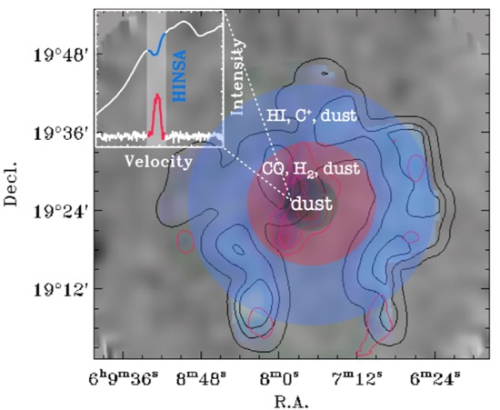Dark space cloud caught donning halo of hydrogen molecules
A chilly cloud of molecular gas in the Milky Way is giving astronomers a rare look at one of the earliest steps in star formation.
Dr.Pei Zuo and Prof.Di Li at the National Astronomical Observatories of Chinese Academy of Sciences (NAOC) and their colleagues used the Arecibo Radio Telescope in Puerto Rico to observe dark clouds. The researchers found that one cloud had an outer ‘shell’ of atomic hydrogen that was being converted into molecular hydrogen - the first such detection of a dark cloud’s birth.
The smallest, most fundamental molecules in the Universe are created when two hydrogen atoms bond to form hydrogen molecules (H2). This process usually takes place in cold and dark clouds. But the molecule's formation is rarely observed, because it's hard to distinguish atomic and molecular hydrogen from other types of molecules and from each other. This work presents the discovery of a rare, isolated dark cloud currently undergoing H2 formation, as evidenced by a prominent "ring" of HI self-absorption. Though a combined analysis of HI narrow self-absorption (HINSA), CO emission, dust emission, and extinction, the researchers directly measured, for the first time, the [HI]/[H2] abundance varying from 2% to 0.2%, within one region.
Further analysis of the rate of H2 formation suggested that the cloud is roughly six million years old. This finding could help to constrain models of star, planet and galaxy formation, the authors write.
Paper link:http://iopscience.iop.org/article/10.3847/1538-4357/aad571/meta
Nature research highlights:https://www.nature.com/articles/d41586-018-07280-6

Figure: the 2MASS extinction overlaid with the ratio of [HI]/[H2] column densities (black contour and blue shadow), and [13CO]/[H2] column density (red) respectively ofsourceB227. The black contours are at 10%, 40%, and 70% of maximum value of 2.1×10-2. The white square shows the corresponding HINSA.